New Philadelphia |
New Philadelphia |
| We will not hold a field school at New Philadelphia in the summer of 2016. Chris Fennell offers a 2016 field school in Edgefield, South Carolina. Follow this link for a collection of online field school directories to explore other opportunities for 2016. |
Field School Objectives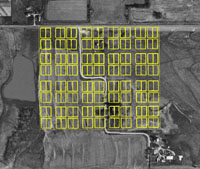
The New Philadelphia story is both compelling and unique. Many studies in historical archaeology that concentrate on African-American issues have focused on plantation life and the pre-emancipation era. The history of New Philadelphia is very different. It is a chronicle of racial uplift and centering on the success of an African-American family and their ability to survive and prosper in a racist society. In 1836, Frank McWorter, an African American who was born into slavery and later purchased his own freedom, acquired 42 acres of land in the sparsely populated area of Pike County, Illinois, situated in the rolling hills bounded by the Illinois and Mississippi rivers. He founded and platted a town, subdivided the property, and sold lots. McWorter used the revenues from his entrepreneurial efforts to purchase the freedom of sixteen family members, with a total expenditure of $14,000 -- a remarkable achievement. 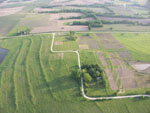
Families of African American and European heritage moved to New Philadelphia and created a multi-racial community. Local residents likely provided "safe house" service for the “Underground railroad” as enslaved African Americans fled northward escaping the oppression of southern plantations. The history of New Philadelphia serves as a rare example of a multi-racial early farming community on the nation’s Midwestern frontier (Walker 1983). The town's population reached its peak of about 160 people in 29 households after the Civil War, a size comparable to many Pike County communities today. However, by the end of the century racial and corporate politics of America’s gilded age resulted in the death knell for the settlement: regional transportation investors routed a new railroad line to pass several miles to the north of the town. Many of New Philadelphia’s residents eventually moved away and, by the early 20th century, only a few families remained (Walker 1983). 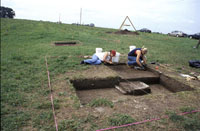
A collaborative project of archaeologists, historians, and members of the local and descendant communities is underway to further research the social history of this demographically integrated town and to enhance its focus in our national memory and heritage. Participating organizations include the University of Illinois at Urbana-Champaign and Springfield, Illinois State Museum, University of North Carolina, University of Iowa, University of Maryland's Center for Heritage Resource Studies, University of Central Florida's Public History Program, the Archaeological Conservancy, and the New Philadelphia Association. Sprague's Kinderhook Lodge has also provided generous support. The town site of New Philadelphia is now a National Historic Landmark based on its significant archaeological resources and exceptional value to our national heritage. This NSF-REU sites program will help enhance undergraduate education in scientific methods and analyses in an ongoing long-term project at New Philadelphia. The primary goals of the project are to:
2) Explore and contrast dietary patterns between different households of different ethnic backgrounds by examining faunal and botanical remains; 3) Reconstruct the townscape and town lot uses of different households from different ethnic backgrounds using botanical data and archaeological landscape features; 4) Elucidate the different consumer choices residents of different ethnic backgrounds made in a frontier situation and understand how household choices changed with the increased connection to distant markets and changing perceptions of racialization within the society. 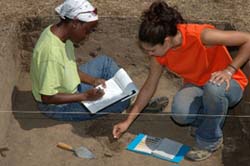
The excavation and analysis of artifacts and archaeobiology data will provide students with a hands-on learning experience and mentoring process for students in an interdisciplinary setting. Ultimately, these different data sets will be integrated and the students will gain an understanding of the importance of scientific interdisciplinary research as they examine the growth and development of the town. This research will elucidate how individual members and families of this integrated community made choices to create their immediate environment, diet, agricultural practices, social affiliation, and consumer choices. Archaeological and Research Setting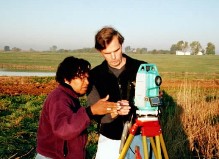
New Philadelphia in Pike County, Illinois is situated between the Illinois and Mississippi rivers. Today, most of the original 42 acres have been returned to agricultural use. Only a few scattered house foundations are visible in the plowed fields. This archaeology project serves as an excellent opportunity for students to participate in many aspects of a scientific research program. Students will be divided into teams and they will work collaboratively on an assigned town lot in New Philadelphia. Prior to excavations, each student will draw from the broader research goals of this project to create an individual and focused research design to be addressed in the course of their field school experience. The field school instructors will teach students about the different archaeological theories used to formulate such research designs, and the methods, sampling, and excavation strategies used in archeology to explore those questions. Each team will be responsible for helping to develop a research design, retrieving archaeological data (material culture and archaeobiology data), cleaning and cataloging the materials, data entry, and analyzing artifacts and archaeobiological materials from one town lot. Student teams will work closely in a mentorship situation with Illinois State Museum, Research and Collection Center (ISM-RCC), University of Illinois, and University of North Carolina staff in order to acquire the necessary skills to perform scientific research. Each student will "specialize" in one form of analysis and they will report on their findings at the end of the summer session. This information will allow students to work as a team to reconstruct the landscape and lifeways of residents of this historic town. Evening lectures will be presented and the group will take several field trips to local historic sites and museums during the ten-week course. Schedule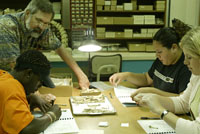 Week 1:
Week 1:Orientation followed by fieldwork at the New Philadelphia site. Students will help conduct and test the results of geophysical and geomorphological surveys of specific lots at the New Philadelphia site. Students will participate in these remote sensing and geoscience investigations. Weeks 2-5: Students will work in teams of three and each team will excavate within a specific town lot or work on excavations related to geoscience analysis of the landscape history of the community. This work will be based on historical research and the results of the geophysical and geomorphological surveys. Students will excavate according to standard archaeological techniques. Participants will, among other things, receive training in how to prepare a site for excavation, excavate according to stratigraphy or "arbitrary" levels, describe the sediments and soils, collect archaeobotanical samples, perform detailed note taking, take accurate measurements, create scale drawings, learn field photography, and do mapping with a computerized laser transit (called a total station) and a highly accurate GPS locational device. Weeks 6-10: Students will be involved in the processing of archaeological information. They will learn how to identify and catalog artifacts, faunal material, seeds and pollen and how to create an associated research catalog and database to be used in analyzing the significance of the evidence we have uncovered. This work will be performed in the ISM-RCC. Results
At the end of the course student teams will make a presentation of their results. Field school staff and members of the community interested in this archaeology project will be invited to a half-day symposium to listen to and discuss the results presented by each team member. The presentation will allow for the dissemination of new information as well as group assessment and constructive critique of the work of each field school participant and the overall project. With the help of field school instructors, this presentation will introduce students to the skill of public speaking and it will help provide them the techniques for communicating scientific results to a public audience. After this presentation and discussion, student teams will assess evaluations and create a strategy on how to best present this work to other audiences. They can also provide their assessments of the priorities that should be placed on the various research goals to be pursued in ongoing historical and archaeological investigations at the New Philadelphia site. Project Location, Facilities and Student Stipends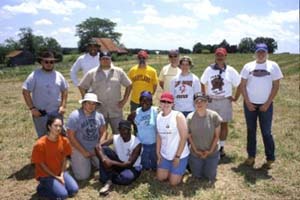
All students are required to be in Pike County on May 23 and the instructions will begin on May 24. New Philadelphia is about 75 miles west of Springfield, Illinois, and 25 miles east of Hannibal, Missouri. There is no mass transportation to the immediate area. The closest town is Barry, Illinois (population 1400) where students will stay at the Kinderhook Lodge. Lodging and meals will be provided during weeks 1-5 while staying in Pike County and students will be transported to the site every day. During the weekends students with access to autos are free to travel and explore the region when fieldtrips are not scheduled. (The Kinderhook Lodge is located between the towns of Kinderhook and Barry on Rt. 106). During weeks 6-10 students will move to the dormitories in Springfield, Illinois and work at the ISM-RCC. This facility provides a state-of-the-art environment and it has vast collections and high quality research laboratories and offices for anthropology, botany, geology, and zoology. During the weekends students are free to travel and explore the region when fieldtrips are not scheduled. Students receive a $450 per week stipend paid on a bi-weekly basis, and the NSF-REU grant also covers the costs of their lodging and meals as described above. Both lodging and meals are provided during weeks 1-5, and lodging (but not meals) are provided during weeks 6-10. (The university may be required to withhold social security tax from each stipend disbursement; we are working to determine if this is necessary). Recommended Items for Field Season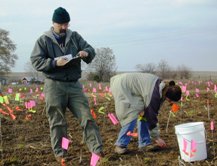
During the laboratory sessions at Illinois State Museum in weeks 6-10, field school participants will be housed in student apartments owned by the University of Illinois, Springfield. Students will need to bring: a couple towels; bedding, including sheets, blankets, pillow (bedding will be provided during the field session in Pike County in weeks 1-5, but not during the laboratory session in Springfield) Faculty Mentors, Adjuncts, and Consulting Personnel
Our thanks to the continuing collaboration and support of the New Philadelphia Association, including advisors Larry Armistead, Phil Bradshaw, Ron Carter, Joe Conover, Allen Kirkpatrick, Pat Likes, Carol McCartney, Sandra McWorter, and Harry Wright, among others. The Archaeological Conservancy now serves as owner, steward, and advisor for research on several acres in the heart of the town site. We also are extremely grateful to the Sprague family for their generous support and hospitality at the Kinderhook Lodge, and to President Woodrow Burt, Dean Betty Anderson, Oran Woodworth, and Pat Likes of Hannibal-LaGrange University for arranging to provide us with a passenger van for transporting field school participants during our stay in Pike County.
Field ManualFollow this link to download a copy of our field manual in Adobe .pdf format. 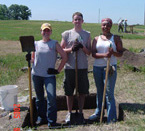
Additional InformationFor additional details about this field school opportunity, please contact Chris Fennell by email at cfennell@illinois.edu, or check the New Philadelphia archaeology web sites for background information on this multi-year project. Materials presented here are based upon work supported by the National Science Foundation under Grant nos. 0353550 and 0752834. Any opinions, findings, conclusions, or recommendations expressed in these materials are those of the author(s) and do not necessarily reflect the views of the National Science Foundation. Department of Anthropology |